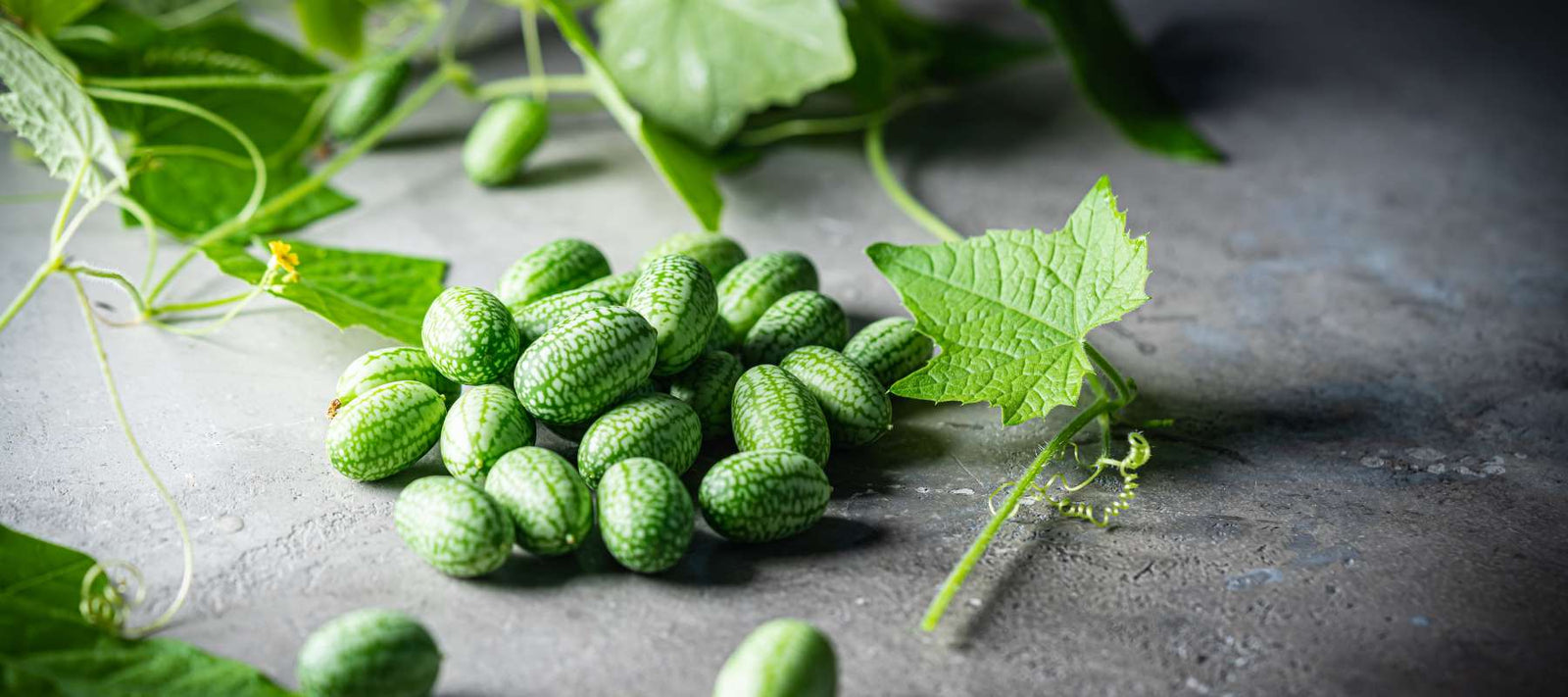Meet one of our lesser-known vegetable seeds: cucamelon, or Melothria scabra. This tangy little fruit is also known as Mexican gherkin, Mexican sour cucumber, pepquino, and sandita. Native to Central America, cucamelon is a vining plant that is distantly related to both cucumbers and melons. It produces small oval fruits that are about the size of a grape and have green stripes. They look very much like mini watermelons but they taste more like citrusy cucumbers.
Why should you add cucamelons to your garden? Here are the top 10 reasons to grow this wonderful plant:
-
Unique Fruits
Although cucamelons have been cultivated for centuries from Mexico to Venezuela, they’re just now beginning to rise in popularity here in the United States. Finding these unusual fruits in stores is difficult, so growing your own is the perfect way to ensure a supply. Plus, it’s a lot of fun to grow a rare seed into a plant that yields such a cute, delicious fruit.
-
Perfect for Small Spaces
If you have limited growing space, you’ll be glad to know that these tiny fruits truly earn the name “mouse melons.” You can easily train the compact vines to grow upwards on a trellis or other support, making the most of vertical space. These container-friendly plants are ideal for growing in hydroponic systems, patio gardens, or even on a balcony.
-
Easy to Grow
These low-maintenance plants are easy to grow from seed to harvest. They have modest fertilizer and water needs. They’ll thrive in warm weather under a variety of soil types and growing conditions.
-
Pest Resistance
These resilient vines have some natural resistance to common garden pests, including those that plague cucumbers like cucumber beetles, squash bugs, aphids, whiteflies, and spider mites.
-
Drought Tolerance
The vines are also drought-resistant once established, which allows gardeners in more growing regions to enjoy growing these delightful plants. Their forgiving nature allows them to rebound if you’ve accidentally forgotten a watering session.
-
Beginner-Friendly
Because they’re not fussy at all, cucamelons are an ideal option for the novice gardener to try something different and rewarding. Whether you’re new to gardening or an old hat, you’ll find that cucamelon plants are a delight to grow.

-
Tangy & Delicious
Cucamelons have a fresh, zesty flavor that is a bit like a cross between a cucumber and a lime - thus the name “Mexican sour gherkin.” They’re fantastic raw, pickled, frozen, or lightly cooked. The whole or sliced fruits are a zingy addition to salads and salsa. Use them anywhere you’d use a cucumber, like ceviche or tacos.
-
Healthy Fruits
Packed with antioxidants, vitamins, and minerals, these tasty little fruits are also quite healthy! They are rich in beta-carotene, Vitamin C, and potassium. They’re also low in calories but high in water and fiber content, making them a filling and guilt-free snack.
-
Kid-Friendly
Children and adults alike find this vine to be a delightful plant to grow from seed to harvest. The plants are compact and manageable, and the adorable little fruits taste great! Add them to your garden for a fun way to introduce your kids to gardening. Don’t be surprised when they also love eating these healthy snacks they grew themselves.
-
Kitchen Versatility
Cucamelons can be enjoyed raw, fresh off the vine, or lightly cooked to preserve their unique flavor. You can store them in the refrigerator for a couple of weeks with good air circulation. Their flavor and crisp texture make them especially well-suited to pickling and fermentation for long-term storage.
How to Grow Cucamelons From Seed

For a head start on the growing season, start cucamelon seeds indoors 4-6 weeks before the last frost. Cover seeds with ½ inch of soil or potting medium, provide plenty of light, and keep the seeds evenly moist. Consider using a heat mat to maintain the optimum germination temperature of 70-80°F. After the last frost in your area, harden off your seedlings and transplant them outside in a sunny, well-drained spot.
Tips for Success
Although cucamelons are resistant to drought, you’ll get a more bountiful harvest if you keep the soil consistently moist but not waterlogged. A sturdy trellis can support the vines' climbing habit and provide airflow, which helps prevent disease. Trellises also make it easier to harvest these small fruits. Pick them when they're grape-sized for the best flavor and to encourage fruit production.
Cucamelon Vs. Creeping Cucumber
Don’t confuse cucamelon with creeping cucumber (Melothria pendula), a wild plant native to the eastern region of the US. Creeping cucumber fruits may look very similar in the early stages, but they will eventually ripen to a purple-black color and become a highly potent laxative! Cucamelons, on the other hand, stay green when they ripen and don’t cause the same gastrointestinal distress. Cucamelon plants are also much more productive because they’ve been cultivated for garden production. If you’ve ever enjoyed foraging creeping cucumber, consider growing cucamelon for an alternative that is much safer and more reliable.
Plant Cucamelon Seeds In Your Garden
If you want a fun, easy addition to your garden, cucamelons are a sure bet! You’ll love how low-maintenance and reliable they are, and you’ll be richly rewarded with an abundance of adorable, tasty fruits from each vine.

























